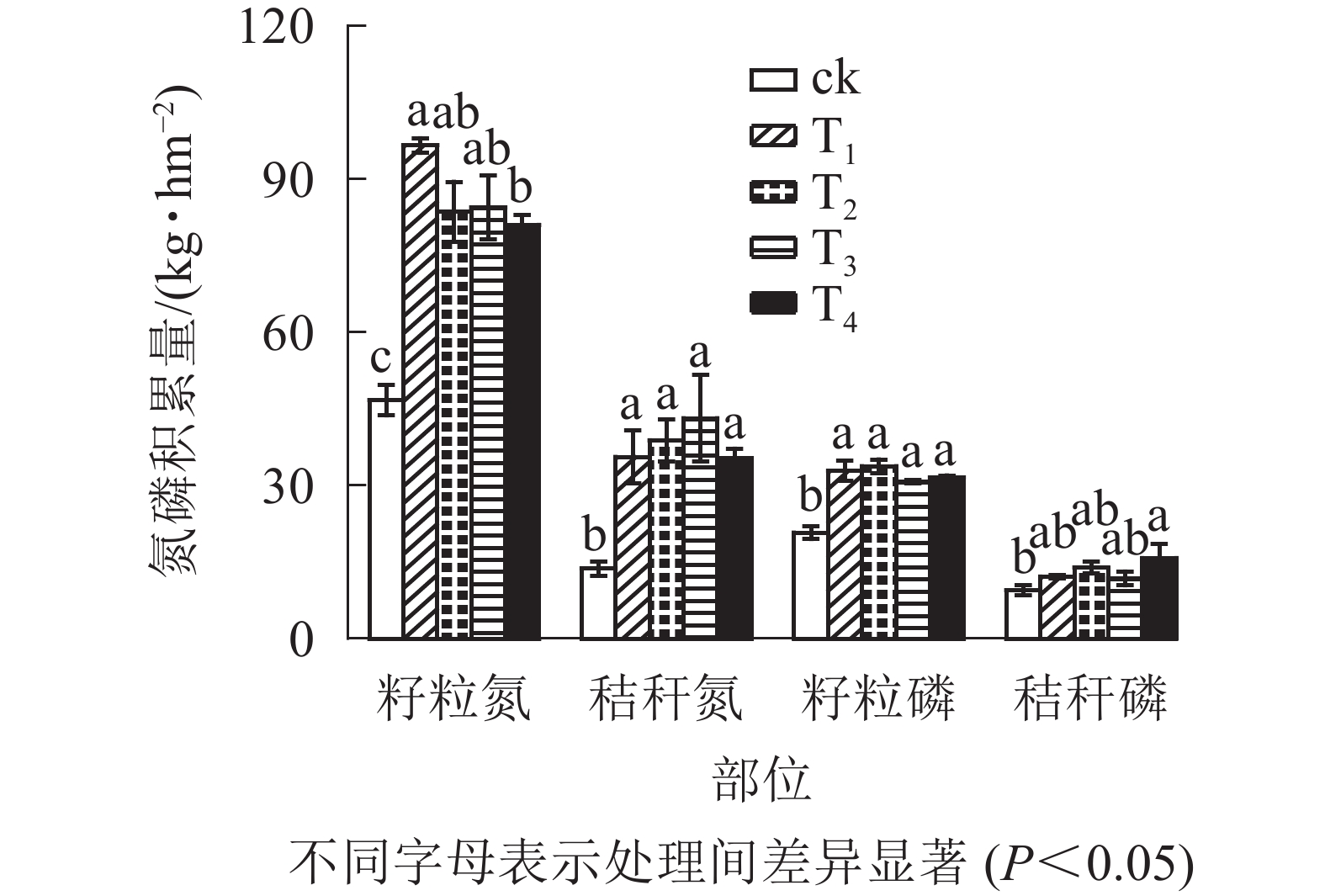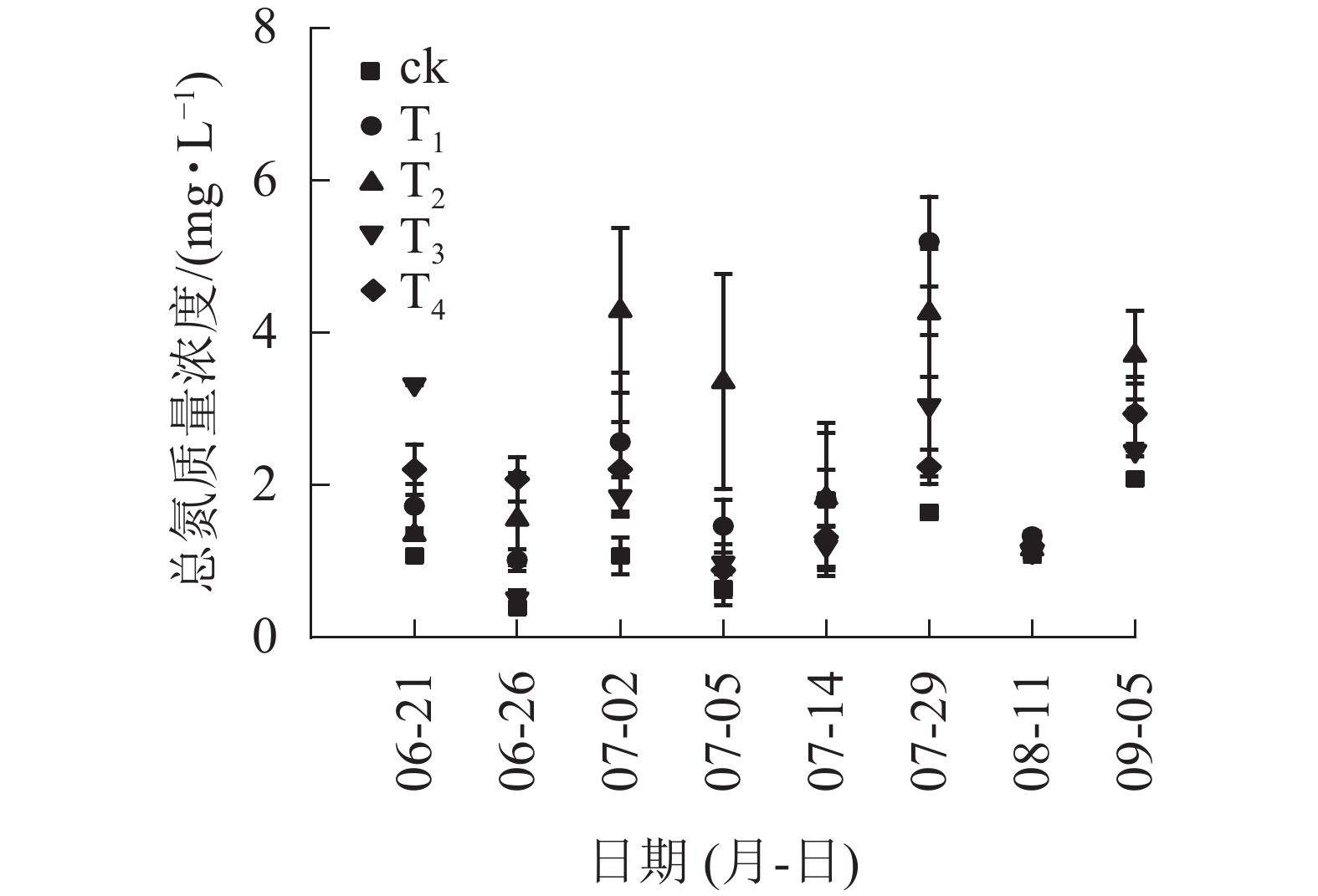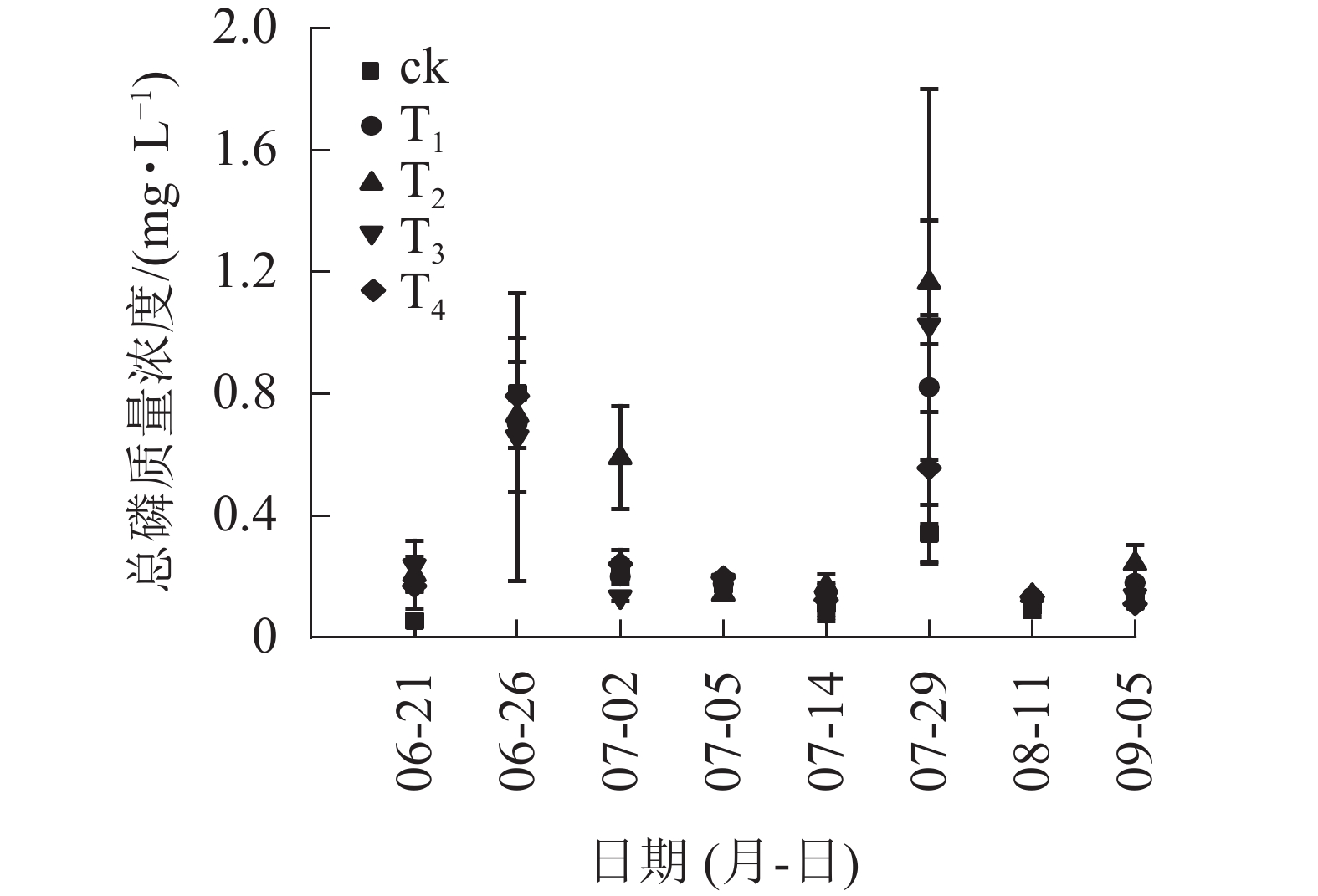-
中国施用化肥量占全球总量的1/3以上[1],施肥重化肥、轻有机肥,存在化肥过量、肥料利用效率低下等诸多问题。过量施肥会导致土壤中的氮含量偏高,造成氮素和磷素流失[2],这些被流失的氮磷会随着地表径流和土壤垂直渗流至湖泊、河流,导致水体污染[3]。氮磷养分流失是农业面源污染的主要来源之一[4]。水质恶化,发黑、发臭,对环境和人体健康产生了严重的负面影响[5]。科学施肥能提高肥料利用率,减少氮磷流失[6]。已有研究发现:化肥配施有机肥可增加作物产量[7],提高氮、磷、钾肥的利用率[8-10],显著降低土壤中的无机氮含量[11];贝壳粉调理剂有提高土壤养分、调节土壤酸碱度的功能[12];生物炭肥料能有效减少磷的损失[13],防止因大量使用化肥而造成的土壤退化,提高氮的利用效率[14],实现作物高产、可持续生产[15]。本研究旨在探究有机肥、调理剂和生物质炭为基质的炭基肥施加对减少氮磷流失、提高肥料利用率以及提高水稻Oryza sativa产量的效应。
HTML
-
试验地位于浙江省杭州市淳安县安阳乡上梧村(30°24′46.4″N,119°51′13.9″E),为山地丘陵区。该区属中亚热带季风气候,四季分明,热量丰富,雨量充沛,光照充足,无霜期长。年均气温为17 ℃,其中最低气温为5.0 ℃,最高气温为28.9 ℃,无霜期为260~270 d,年降水量为1 153~1 864 mm,年均相对湿度为76%。土壤质地为黏土,pH 4.98,有机质为33.30 g·kg−1,全氮为2.07 g·kg−1,全磷为1.14 g·kg−1,全钾为2.56 g·kg−1,有效磷为144 mg·kg−1,速效钾为138 mg·kg−1。
-
本研究在2019年3−10月进行,3−4月建立监测工程小区,共建立15个径流小区,小区面积为6.5 m×4.5 m,随机排列,小区设有独立的灌水、排水系统和径流池装置,径流池面积3.0 m×0.8 m。如表1所示:以等氮量为标准,设置5个不同施肥处理:不施肥(ck),常规施肥(T1),有机肥(T2),常规施肥+调理剂(T3)和炭基肥(T4),随机排列,重复3次。2019年6月14日翻耕农田,6月16日灌水和第1次施肥,6月17日插秧,6月26日对T2、T3处理进行灌水和追肥,T4处理一次性施肥,T1、T2、T3处理分2次施肥,控制氮、磷施加量相等。7月30日开始烤田,10月5日收割水稻并采样。
处理 肥料氮用量/(kg·hm−2) 基肥(6月16日)及用量/(kg·hm−2) 追肥(6月26日)及用量/(kg·hm−2) ck 0 0 0 T1 270.0 复合肥750.0,钙镁磷肥125.0 尿素293.5,氯化钾24.2 T2 270.0 菜籽饼2700.0,钙镁磷肥62.5 尿素293.5,氯化钾24.2 T3 270.0 复合肥750.0,钙镁磷肥125.0,调理剂333.3 尿素293.5,氯化钾24.2 T4 270.0 炭基肥1 500.0 0 Table 1. Fertilization treatments in rice season
供试肥料为复合肥(
$m_{{\rm{N}}}:m_{\rm{{P_{2}O_{5}}}}:m_{\rm{{K_{2}}}O}=18:8:18$ );钙镁磷肥(五氧化二磷质量分数为12%);尿素(氮质量分数为46%);氯化钾(氧化钾质量分数为62%):菜籽饼($m_{{\rm{N}}}:m_{\rm{{P_{2}O_{5}}}}:m_{\rm{{K_{2}}}O}=5.0:2.5:1.0$ );调理剂为海洋生物贝壳类经550 ℃高温煅烧2 h后研磨成2 mm贝壳砂,基本理化性质为pH 9.21,钙57.8 g·kg−1,碳119.1 g·kg−1,硫2.5 g·kg−1,氮0.8 g·kg−1,钾122.0 g·kg−1;炭基肥(遂昌绿金有机肥有限公司研制,$m_{{\rm{N}}}:m_{\rm{{P_{2}O_{5}}}}:m_{\rm{{K_{2}}}O}:m_{\rm{C}}=18:5:10:25$ )。 -
试验开始前和水稻收割之后均采用具有刻度的管形取土器采集,保持田面平整,使采集深度一致,将管型取土器钻入土层,取出土钻时上层水即流走,剩下潮湿土壤装入塑料袋中,小区内“S”型布点采样。采集的样品自然风干后过2 mm筛,封装待测。土壤pH采用pH计测定(m水∶m土=2.5∶1.0);土壤有机质采用重铬酸钾容量法外加热法测定;土壤全氮采用浓硫酸消煮-半微量开氏法测定;土壤全磷采用高氯酸-硫酸消煮-钼锑抗比色法测定;土壤全钾采用氢氧化钠熔融-火焰光度法测定;土壤有效磷采用0.5 mol·L−1碳酸氢钠浸提-钼锑抗比色法测定;土壤速效钾采用醋酸铵浸提-火焰光度法测定;土壤硝氮、氨氮采用氯化钾浸提-流动分析仪测定[16]。
-
水稻收割后,每小区采集1 m2有代表性的水稻植株和秸秆,将水稻籽粒烘干后称量,测定其平均含水率,测定水稻籽粒和秸秆的全磷、全氮质量分数。样品用硫酸-过氧化氢消煮,全磷采用钼锑抗分光光度法测定,全氮采用奈氏比色法测定[16]。
-
水稻生长期间,在降雨产生径流后根据径流池内的水深,计算出径流水量,并采集径流水样测定。径流水样的总磷采用过硫酸钾消解-钼酸铵分光光度法测定;总氮采用碱性过硫酸钾消解-紫外分光光度法测定[16]。
-
通过地表径流途径流失的氮磷量等于整个监测期间各次径流水中氮磷的质量浓度与径流水体积乘积之和。计算公式为:
$P = \sum\limits_{i = {\rm{1}}}^n {{C_i}} \times {V_i}$ 。其中:P为氮磷流失量(kg·hm−2);Ci为第i次径流水中氮、磷的质量浓度(mg·L−1);Vi为第i次径流水的体积(m3);n为总径流次数。流失率等于不同施肥处理氮/磷径流总量与不施肥相比增加的百分比。计算公式为:η$ {\rm{η}}_{\rm{L}}=\dfrac{({L}_{{\rm{m}}}-{L}_{0})}{{L}_{0}}\times100\%$ 。其中:ηL为流失率(%);Lm为氮/磷流失量(kg·hm−2);L0为不施肥处理径流总量(kg·hm−2)。肥料的养分利用率等于不同施肥处理作物氮/磷吸收积累总量比不施肥处理增加量占肥料中氮/磷量的百分比。计算公式为:η$ {\rm{η}}_{\rm{F}}=\dfrac{({A}_{{\rm{d}}}-{A}_{0})}{F}\times100\%$ 。其中:ηF为肥料利用率(%);Ad为不同施肥处理下作物氮/磷积累量(kg·hm−2);A0为不施肥处理下作物氮/磷积累量(kg·hm−2);F为肥料中的氮/磷量。采用Origin 2018作图,SPSS 22.0进行数据分析及方差分析。
1.1. 试验地概况
1.2. 试验设计
1.3. 样品采集与分析
1.3.1. 土壤样品采集与分析
1.3.2. 作物样品采集与分析
1.3.3. 径流水样品采集与分析
1.4. 数据处理与分析
-
由表2可以看出:pH、有机质、全氮、全磷、有效磷、速效钾在不同施肥处理之间均没有显著差异(P>0.05)。T3处理的土壤全钾质量分数相较于ck增加了68.98%(P<0.05)。不同施肥处理相较于ck均能增加4.96%~45.39%土壤碱解氮,其中T3、T4处理显著高于T1、T2处理(P<0.05)。
处理 pH 有机质/(g·kg−1) 全氮/(g·kg−1) 全磷/(g·kg−1) 全钾/(g·kg−1) 有效磷/(mg·kg−1) 速效钾/(mg·kg−1) 碱解氮/(mg·kg−1) 本底 4.98 33.30 2.07 1.14 25.60 144 138 133 ck 5.03±0.25 a 30.00±0.75 a 1.57±0.14 a 0.83±0.02 a 9.35±0.26 b 57±3 a 72±5 a 141±3 c T1 5.19±0.22 a 25.07±2.03 a 1.29±0.16 a 0.96±0.15 a 10.37±0.77 ab 107±43 a 82±8 a 150±4 b T2 5.14±0.07 a 28.67±0.44 a 1.62 ±0.21 a 0.95±0.02 a 11.53±1.47 ab 84±3 a 79±12 a 148±3 bc T3 5.67±0.26 a 24.23±2.85 a 1.46±0.26 a 0.91±0.09 a 15.80±3.12 a 102±35 a 68±26 a 205±2 a T4 5.07±0.20 a 33.73±8.66 a 1.45±0.10 a 0.84±0.04 a 10.33±1.28 ab 74±18 a 65±2 a 197±1 a 说明:数据为平均值±标准差;不同字母表示处理间差异显著(P<0.05) Table 2. Soil chemical properties of different fertilization treatments
-
由图1可知:不同肥料施用均显著增加了水稻籽粒产量(P<0.05)。与ck相比,T1、T2、T3和T4处理的水稻产量分别增产60.16%、63.41%、52.84%和51.22%,4种不同施肥处理间的产量没有显著性差异(P>0.05)。
-
如表3所示:在水稻籽粒中,不同施肥处理氮质量分数差异显著(P<0.05),其中以T1处理最高,为10.93 g·kg−1,其次是T3处理,以ck处理最低;磷质量分数无显著差异(P>0.05),与ck相比,T1、T2、T3处理有略微下降;钾质量分数从高到低依次为ck、T2、T4、T1和T3,不同施肥处理均呈下降趋势。在水稻秸秆中,氮质量分数以T3处理最高,相较于ck,增加了107.35%,差异显著(P<0.05);与ck相比,除T4处理外,磷质量分数均减小,但差异不显著(P>0.05);钾质量分数没有明显的变化规律,其中以T3处理最高,为31.64 g·kg−1,T4处理最低,各处理之间无显著差异(P>0.05)。
处理 籽粒/(g·kg−1) 秸秆/(g·kg−1) 氮 磷 钾 氮 磷 钾 ck 8.41±0.18 c 3.74±0.07 a 4.63±0.08 a 2.45±0.14 b 1.70±0.09 a 31.03±0.65 a T1 10.93±0.36 a 3.71±0.14 a 4.15±0.14 bc 3.99±0.44 ab 1.37±0.05 a 29.11±1.50 a T2 9.22±0.40 bc 3.73±0.11 a 4.51±0.22 ab 4.28±0.34 a 1.53±0.09 a 28.22±0.17 a T3 9.98±0.67 ab 3.63±0.08 a 4.03±0.06 c 5.08±0.94 a 1.39±0.15 a 31.64±1.47 a T4 9.69±0.18 abc 3.77±0.08 a 4.16±0.09 bc 4.22±0.10 a 1.90±0.39 a 28.12±1.51 a 说明:数据为平均值±标准差;不同字母表示处理间差异显著(P<0.05) Table 3. Contents of N and P in rice plants
如图2所示:在水稻籽粒中,氮积累量从高到低依次为T1、T3、T2、T4、ck,且T1处理相较于ck显著增加了106.9%(P<0.05);与ck相比,磷积累量均显著增加(P<0.05),但不同施肥处理之间无显著差异(P>0.05)。在水稻秸秆中,氮积累量以T3处理增量最大,较ck处理增加了29.48 kg·hm−2,T1、T2、T3和T4处理积累量均显著高于ck (P<0.05);磷积累量相较于ck,只有T4处理显著增加(P<0.05),增量为4.39 kg·hm−2,其他施肥处理的磷积累量均无差异。且在不同施肥处理下,水稻籽粒和秸秆对氮的积累量,除T1处理外,T2、T3和T4处理均有相同的变化趋势;对磷积累量,除T4处理外,均有相同的增加趋势,从高到低依次为T2、T1、T3。
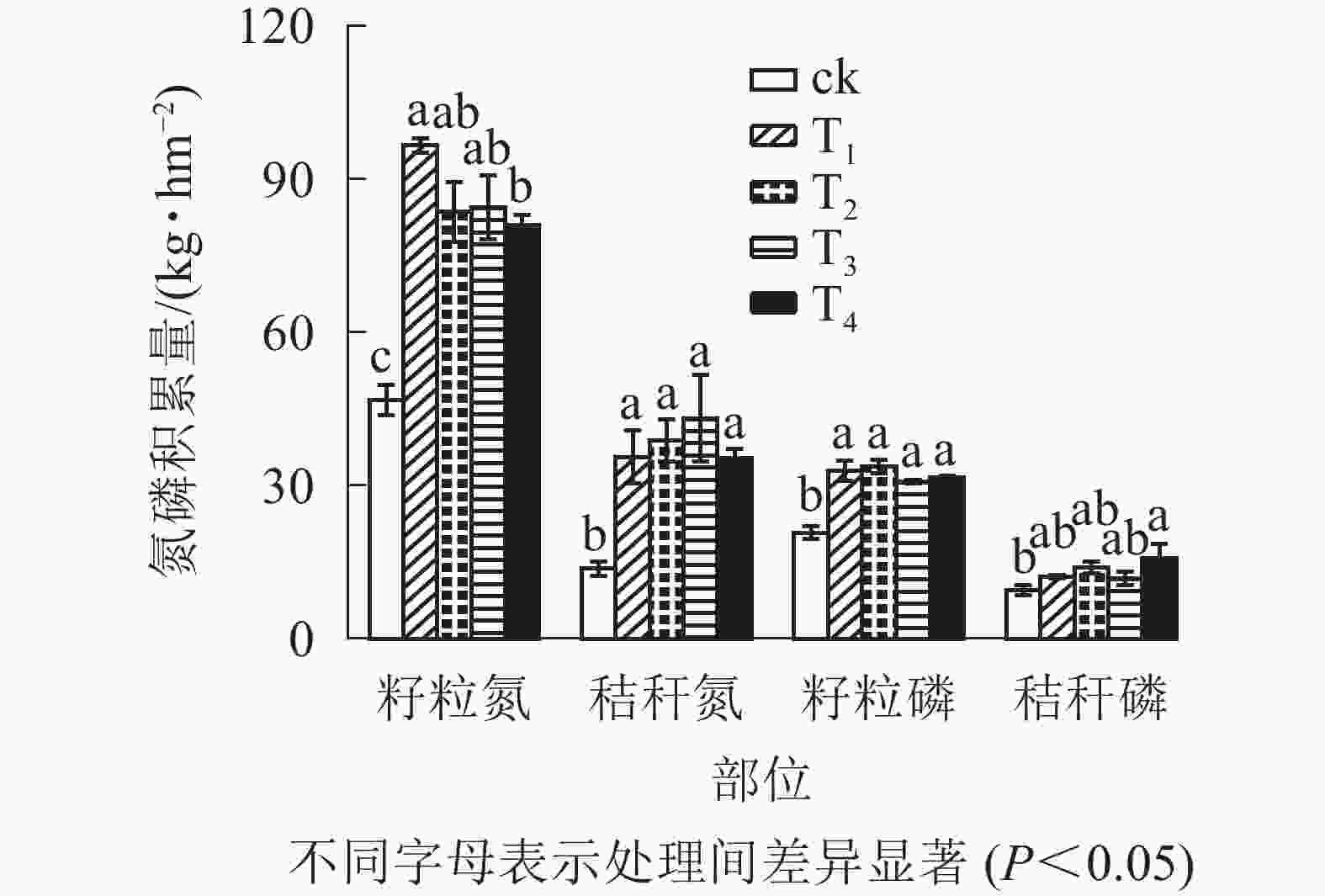
Figure 2. Accumulation rates of nitrogen and phosphorus in grains and straws of rice with different fertilization treatments
如图3所示:不同施肥处理的氮肥利用率为20.74%~26.59%,以T1处理最高,T4处理最低,磷肥利用率从高到低依次为T2、T4、T1、T3,不同处理间均没有显著差异(P>0.05)。
-
从图4可以看出:T3处理径流总氮起始质量浓度最高,7月2日和5日,T2处理总氮质量浓度明显高于其他处理。水稻季期间T1、T2、T3处理的总氮质量浓度有明显的起伏变化,ck、T4处理总氮质量浓度变化波动平缓,总体趋于稳定。从图5可以看出:6月26日和7月29日的径流总磷质量浓度明显高于其他时间,不同施肥处理的总磷整体质量浓度变化趋势相同,但最终都趋于稳定。
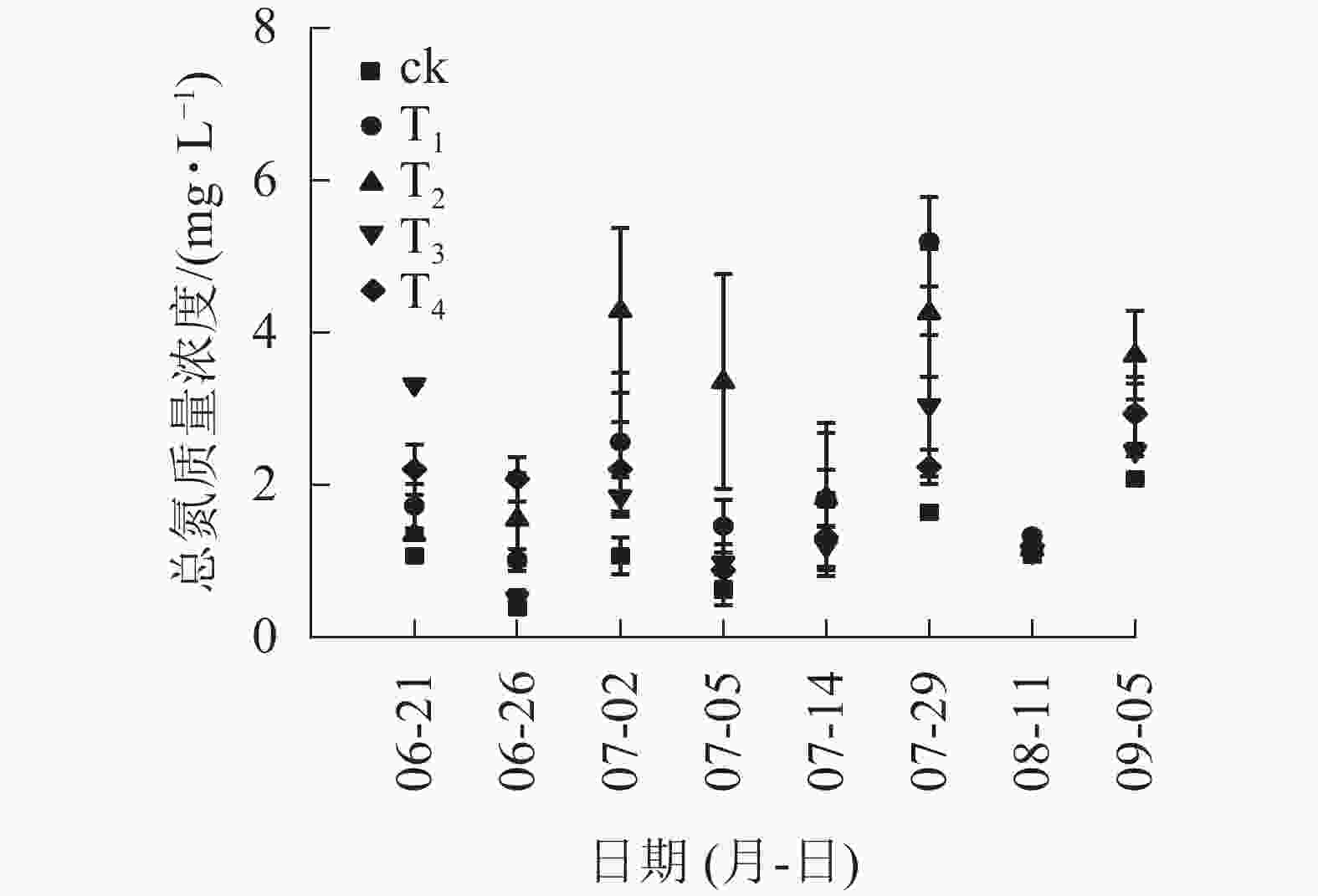
Figure 4. Changes of total nitrogen concentrations in runoff from different fertilization treatments with time
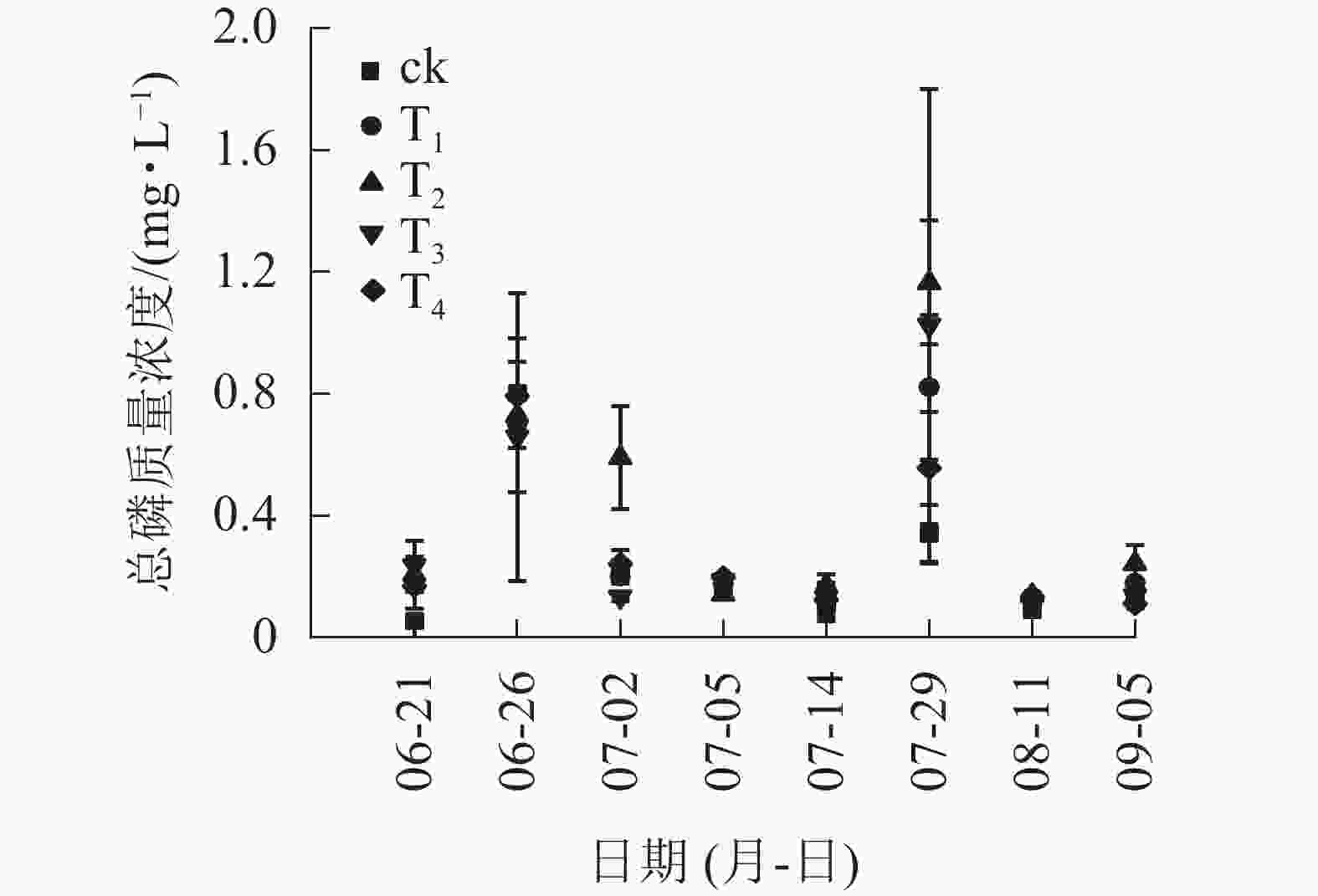
Figure 5. Changes of total phosphorus concentrations in runoff from different fertilization treatments with time
从表4可以看出:与ck相比,T1、T2、T3和T4处理的氮流失量均显著增加(P<0.05),其中以T2处理最大,增加了94.70%。T1、T2、T3和T4处理的磷流失量分别增加了47.14%、92.86%、37.14%和30.00%,其中T2处理流失量显著高于T4。氮、磷流失率分别为0.82%~1.72%、0.65%~1.99%,不同处理间均无显著差异(P>0.05)。不同施肥处理氮磷流失量的增幅和流失率的大小变化均呈现相同的趋势。
处理 流失量/(kg·hm−2) 流失率/% 氮 磷 氮 磷 ck 4.91±0.01 c 0.70±0.05 b T1 7.83±0.17 ab 1.03±0.08 ab 1.08±0.07 a 1.03±0.37 a T2 9.56±1.22 a 1.35±0.12 a 1.72±0.46 a 1.99±0.50 a T3 7.64±0.77 ab 0.96±0.19 ab 1.01±0.29 a 0.79±0.71 a T4 7.13±0.49 b 0.91±0.14 b 0.82±0.18 a 0.65±0.38 a Table 4. Nitrogen and phosphorus runoff loss and loss rate
2.1. 不同施肥处理对土壤养分的影响
2.2. 不同施肥处理对作物产量的影响
2.3. 不同施肥处理对水稻氮磷吸收及利用率的影响
2.4. 不同施肥处理对径流氮磷流失的影响
-
本研究表明:不同肥料施用均能使水稻显著增产,但4种不同施肥处理之间产量无显著差异(P>0.05)。由ck土壤碱解氮质量分数显著低于T1、T3、T4处理可知,不同施肥处理的增产效应是由不施肥处理土壤养分供应不足所导致。施加有机肥,能提高土壤pH和养分含量[17];调理剂具有比表面积大,孔隙度大等特点,能改善土壤理化性质[18],有效供应养分;炭基肥能增强水稻的光合作用[19],改良土壤性质,增加水稻生物量的产量[20],因此不同施肥处理水稻均能增产[21]。除了T3和T4处理土壤碱解氮显著高于T1和T2处理外(P<0.05),不同处理之间的土壤pH、有机质和养分质量分数均无显著差异(P>0.05),从而导致了不同施肥处理之间的水稻籽粒产量无显著差异(P>0.05)。
-
本研究表明:不同施肥处理的籽粒氮、磷质量分数及秸秆氮质量分数均显著高于ck (P<0.05),这与崔新卫等[22]的研究结果一致。施加炭基肥同时增加了籽粒和秸秆的氮磷积累量,这可能是由于生物炭的施加提高了土壤的供肥能力,同时增强了作物光合作用[23],说明不同施肥处理均能有效供应作物所需的养分。然而,4种不同施肥处理的水稻氮磷积累量和肥料利用率均无显著差异(P>0.05),可能是不同施肥处理的供肥能力差异较小所致。
-
T2处理径流流失量最大,且大于T1处理,即本研究施加有机肥没有有效减少径流氮磷流失,这与HUSAIN[24]研究结果不同。可能是由于6月26日对T2处理进行追肥,当天降雨,产生了径流,导致追肥的肥料未被土壤和作物吸收就被雨水大量冲刷,产生了径流水中最大的质量浓度;7月29日,降雨量大,导致产生了最大径流水量。这与王莺等[25]研究结果一致,即降雨是影响径流的重要因子,径流量和降雨量存在显著正相关。因此,T2处理产生了最大的径流流失量。
贝壳粉调理剂具有比表面积大、孔隙度大等特点,且贝壳粉炭为碱性,能使土壤pH升高,有利于改善土壤养分,提高肥料利用率,增加土壤保肥能力[26-28]。生物炭基肥由于其特殊的结构和理化性质,可以吸附土壤中未被作物利用的水分和养分,延缓养分释放,减弱其在土壤中的迁移转化能力[29],提高土壤氮养分的有效性。这与本研究结果一致。本研究表明:T3和T4处理均能使土壤pH升高,从而有利于土壤中氮磷的吸附和固定[30],减少未被作物吸收的氮磷,从而提高肥料利用率,减少氮磷流失。
因此,在施用不同肥料时,要注意施肥方式和时间,避免由于一次性大量施入肥料或者施肥后遭遇强降水而导致的径流流失量的剧增。在水稻生长期应合理控制灌溉和水肥管理,重视和提倡合理施肥方法,控制稻田氮磷的径流量,从而减少氮磷流失带来的环境污染[31-32]。
3.1. 不同肥料施用对土壤性质、水稻产量的影响及机制
3.2. 不同肥料施用对作物氮磷吸收积累量及肥料利用率的影响
3.3. 不同肥料施用对径流氮磷流失的影响及机制
-
4种不同施肥处理均能显著提高水稻产量,其增产率为51.22%~63.41%,但不同肥料之间增产无显著差异(P>0.05)。氮和磷的流失量分别介于4.91~9.56和0.70~1.35 kg·hm−2,不同处理的流失量均按如下次序递减:T2、T1、T3、T4、ck。氮和磷的流失率分别为0.82%~1.72%和0.65%~1.99%,大小均按如下次序递减:T2、T1、T3、T4,不同施肥处理之间无显著差异(P>0.05)。T2处理的径流流失量最大,T3和T4处理能有效减少氮磷流失。因此,要注意合理的施肥方式和时间,从而减少氮磷流失造成的面源污染。




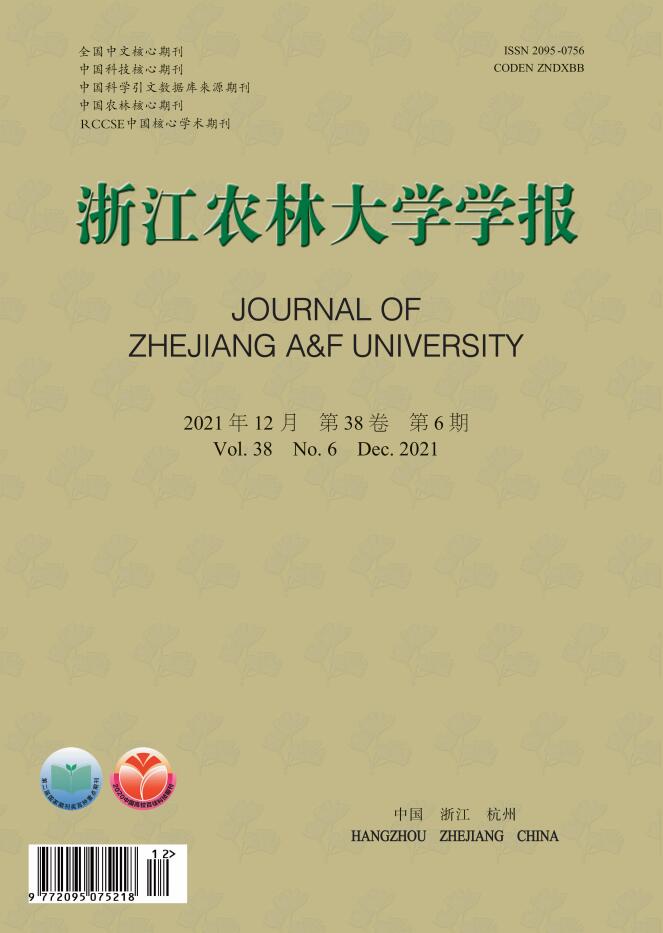


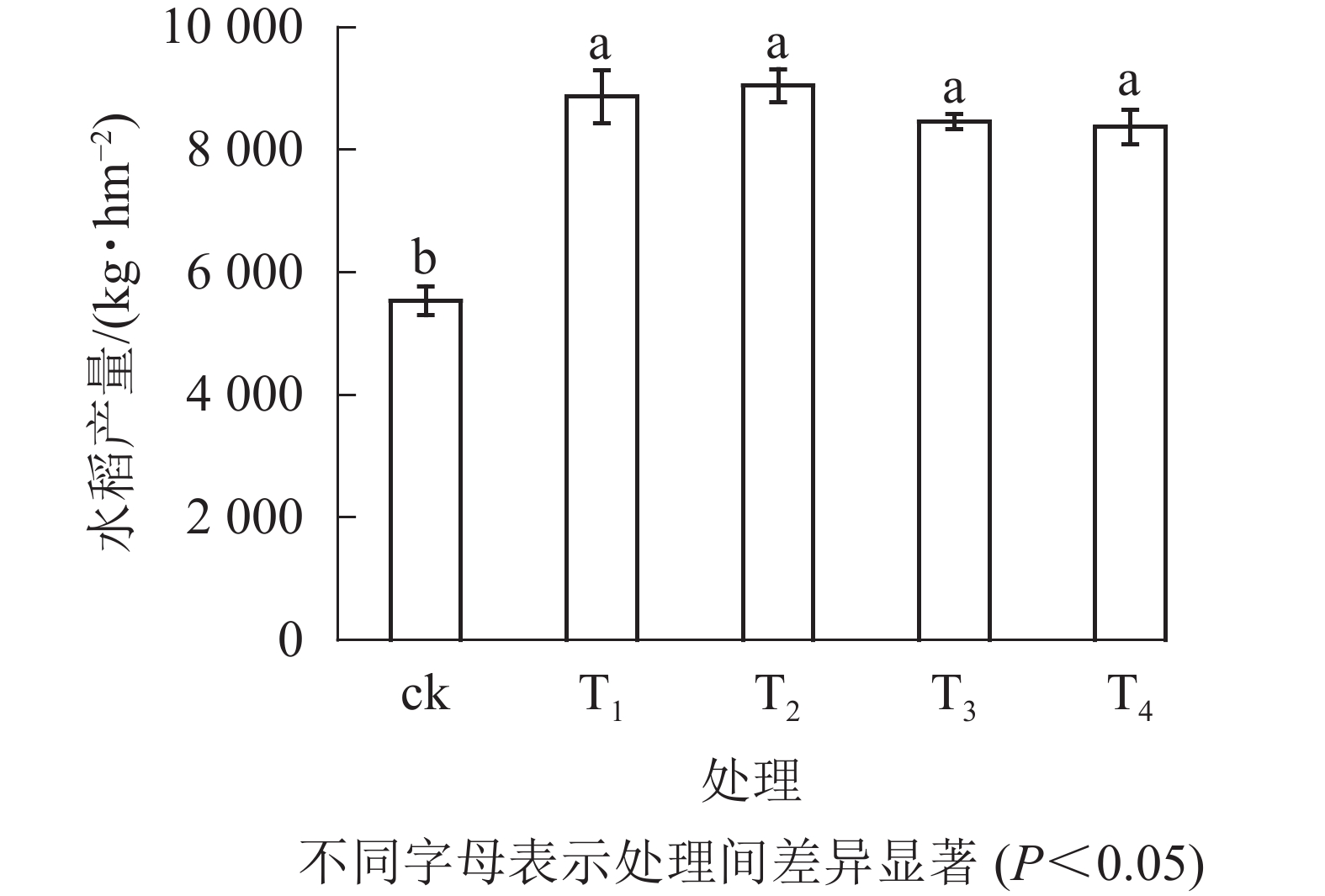








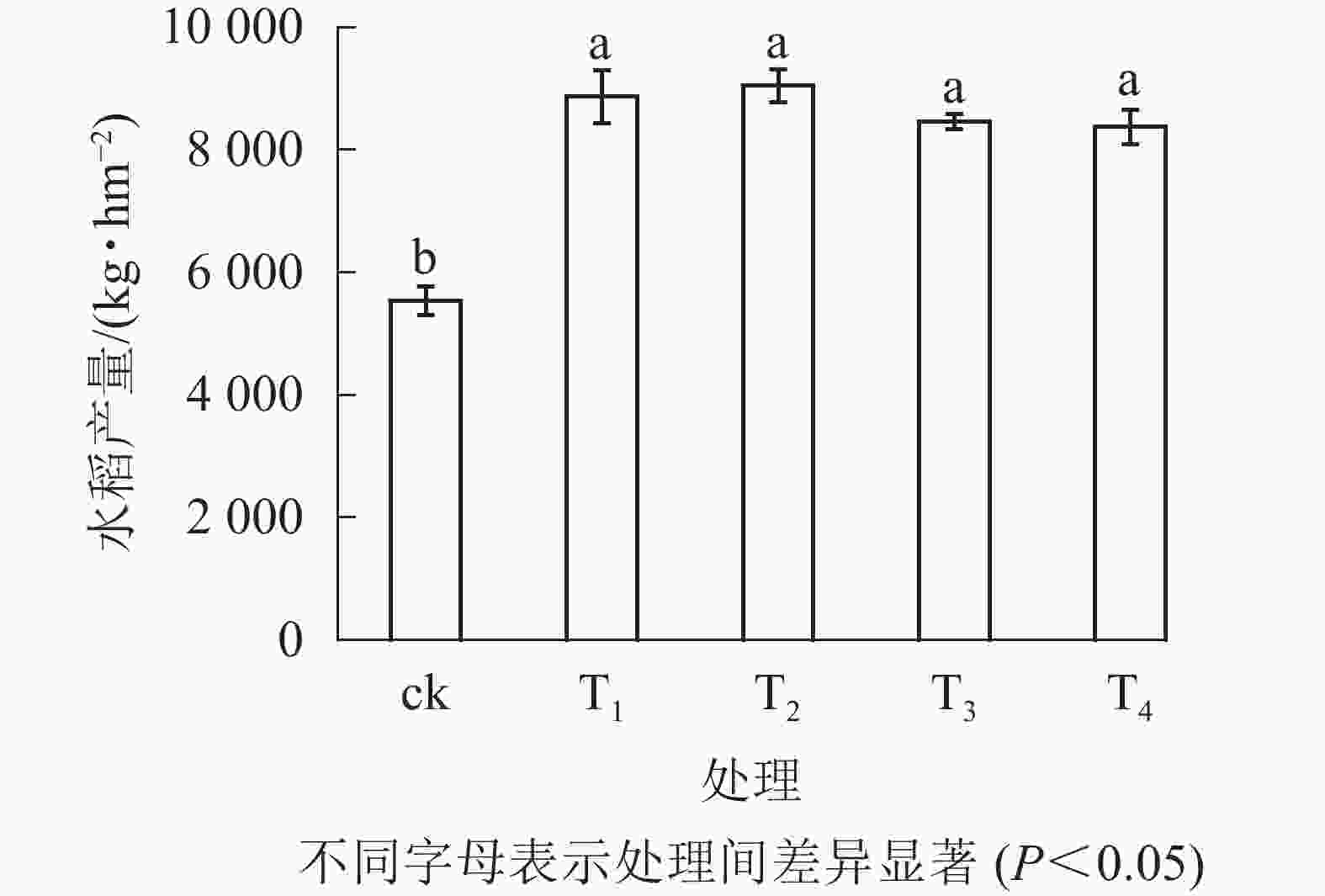
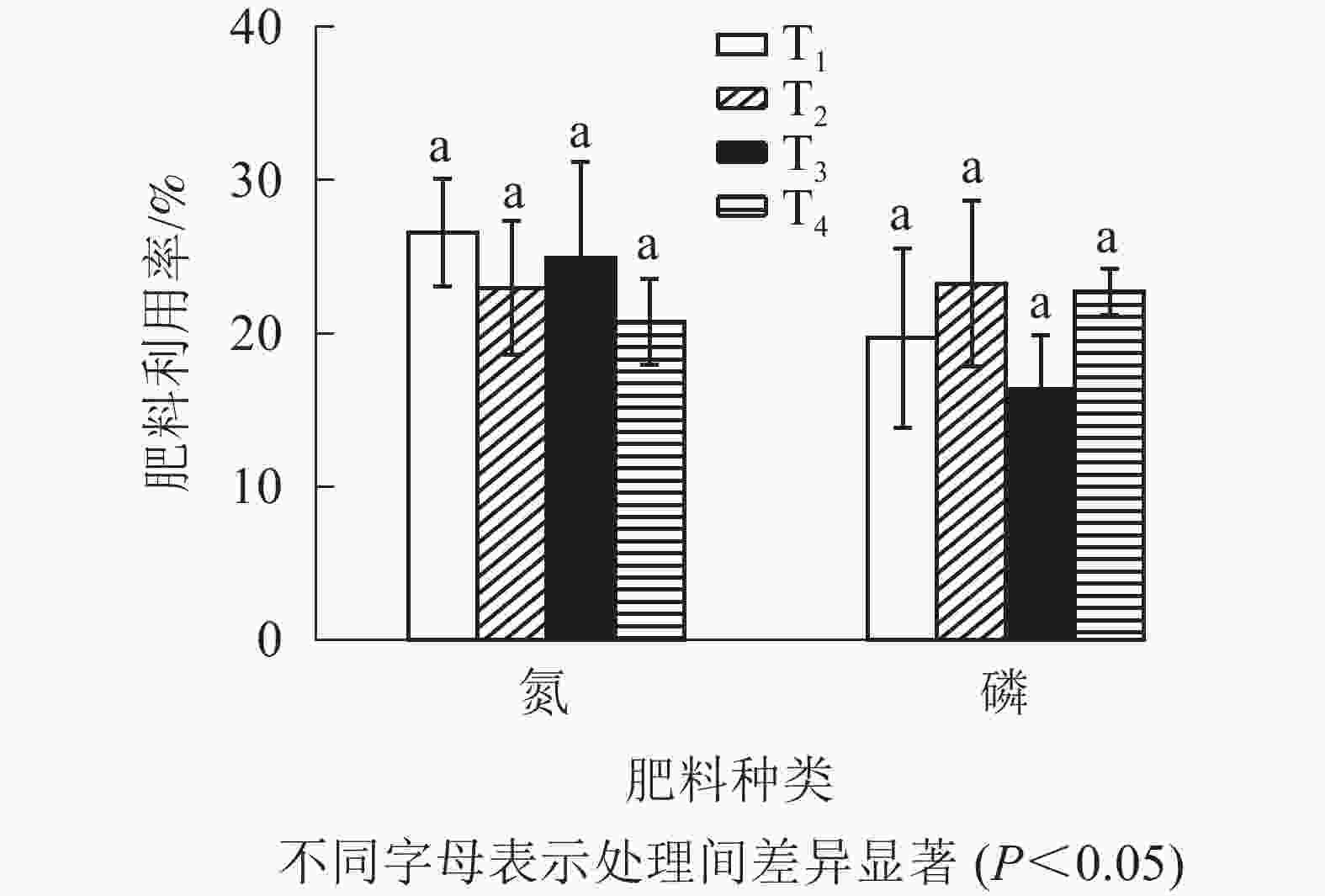
 DownLoad:
DownLoad:
